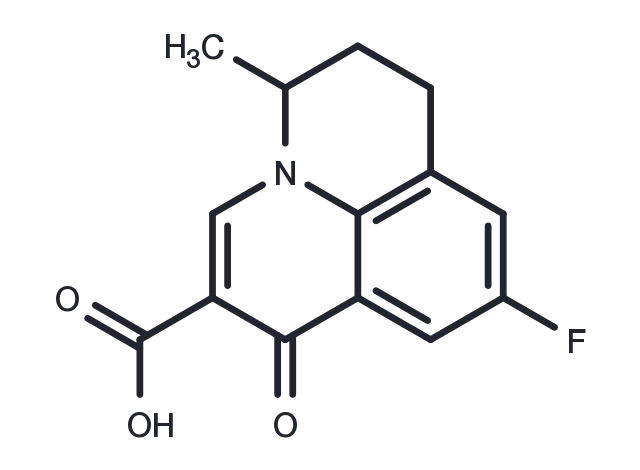Powder: -20°C for 3 years | In solvent: -80°C for 1 year


Flumequine (R-802) is a broad-spectrum antibiotic that is active against both Gram-positive and Gram-negative bacteria. It functions by inhibiting DNA gyrase, a type II topoisomerase, and topoisomerase IV, enzymes necessary to separate bacterial DNA, thereby inhibiting cell division.

| Pack Size | Availability | Price/USD | Quantity |
|---|---|---|---|
| 50 mg | In stock | $ 33.00 | |
| 100 mg | In stock | $ 46.00 | |
| 200 mg | In stock | $ 63.00 | |
| 1 mL * 10 mM (in DMSO) | In stock | $ 51.00 |


| Description | Flumequine (R-802) is a broad-spectrum antibiotic that is active against both Gram-positive and Gram-negative bacteria. It functions by inhibiting DNA gyrase, a type II topoisomerase, and topoisomerase IV, enzymes necessary to separate bacterial DNA, thereby inhibiting cell division. |
| Targets&IC50 | Topo II:15 μM |
| In vitro | At a concentration of 100 mg/L, Flumequine reduced the average length of roots, hypocotyls, and cotyledons in the water plant Lythrum salicaria L., and diminished the count of secondary roots. After oral administration of 10 mg/kg Flumequine, the total clearance rates were 0.024 L/h.kg (cod) and 0.14 L/h.kg (dab), with elimination half-lives (t1/2 λ z) of 75 hours (cod) and 31 hours (dab). The bioavailability of Flumequine following oral administration was measured at 65% (cod) and 41% (dab). Dose-dependent DNA damage in the stomach, colon, and bladder of adult mice was observed after oral administration of 4000 ppm Flumequine for 3 hours instead of 24 hours. In Atlantic salmon, the stable apparent volume of distribution was 3.5 L/kg after intravenous administration of Flumequine, with an elimination half-life (t 1/2) of 22.8 hours, and the area under the plasma drug concentration-time curve (AUC) was 140 µg×hour/mL. |
| In vivo | Flumequine demonstrates a minimum inhibitory concentration (MIC) ranging from 0.06 μg/mL to 32 μg/mL across 12 clinically isolated Salmonella strains. The high E(max) values for most resistant strains, reaching up to 16, indicate its significant contribution to combating resistant phenotypes. Accumulation studies have shown that these high E(max) values correlate with lower levels of accumulation. Flumequine's inhibition of eukaryotic topoisomerase II, associated with the double-stranded DNA breakage reaction, is the underlying cause for its effect on bacterial gyrase, suggesting a strong correlation between its action on topoisomerase II and the bacterial gyrase inhibition. |
| Synonyms | Flumigal, R-802 |
| Molecular Weight | 261.25 |
| Formula | C14H12FNO3 |
| CAS No. | 42835-25-6 |
Powder: -20°C for 3 years | In solvent: -80°C for 1 year
Ethanol: < 1 mg/mL (insoluble or slightly soluble)
H2O: < 1 mg/mL (insoluble or slightly soluble)
DMSO: 3 mg/mL (11.48 mM)
You can also refer to dose conversion for different animals. More
bottom
Please see Inhibitor Handling Instructions for more frequently ask questions. Topics include: how to prepare stock solutions, how to store products, and cautions on cell-based assays & animal experiments, etc.
Flumequine 42835-25-6 DNA Damage/DNA Repair Microbiology/Virology Topoisomerase Antibacterial Antibiotic Flumigal inhibit Inhibitor Bacterial R802 R 802 R-802 inhibitor
